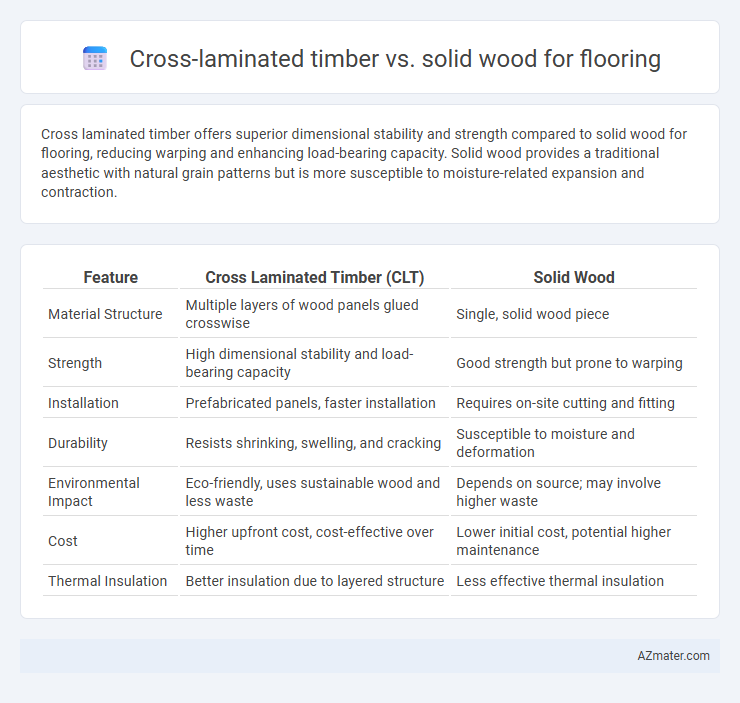Cross laminated timber offers superior dimensional stability and strength compared to solid wood for flooring, reducing warping and enhancing load-bearing capacity. Solid wood provides a traditional aesthetic with natural grain patterns but is more susceptible to moisture-related expansion and contraction.
Table of Comparison
| Feature | Cross Laminated Timber (CLT) | Solid Wood |
|---|---|---|
| Material Structure | Multiple layers of wood panels glued crosswise | Single, solid wood piece |
| Strength | High dimensional stability and load-bearing capacity | Good strength but prone to warping |
| Installation | Prefabricated panels, faster installation | Requires on-site cutting and fitting |
| Durability | Resists shrinking, swelling, and cracking | Susceptible to moisture and deformation |
| Environmental Impact | Eco-friendly, uses sustainable wood and less waste | Depends on source; may involve higher waste |
| Cost | Higher upfront cost, cost-effective over time | Lower initial cost, potential higher maintenance |
| Thermal Insulation | Better insulation due to layered structure | Less effective thermal insulation |
Introduction to Cross Laminated Timber (CLT) and Solid Wood
Cross Laminated Timber (CLT) is an engineered wood product made by gluing layers of solid wood boards in alternating directions, offering enhanced structural stability and strength compared to traditional solid wood. Solid wood flooring, composed of single pieces of natural timber, provides classic aesthetics and durability but can be more prone to warping and shrinking under environmental changes. CLT's dimensional stability and sustainability make it an innovative alternative to solid wood for flooring applications, especially in modern construction.
Structural Performance: Strength and Stability
Cross laminated timber (CLT) offers superior structural performance compared to solid wood due to its multi-layered construction, which enhances strength, stiffness, and dimensional stability. The crosswise lamination in CLT significantly reduces the risk of warping, twisting, and splitting, providing consistent load-bearing capacity and resistance to deformation under heavy loads. Solid wood, while strong in compression, is more susceptible to natural flaws and anisotropic behavior, resulting in less predictable performance for floor applications.
Material Composition and Manufacturing Process
Cross laminated timber (CLT) consists of multiple layers of timber boards stacked crosswise and glued, providing enhanced dimensional stability and strength compared to solid wood. Solid wood floors are made from single pieces of natural timber, retaining original grain and structure but prone to warping and shrinkage due to moisture. The manufacturing process of CLT involves precision-cutting, layering, and pressing under controlled conditions, while solid wood flooring is milled directly from raw timber, requiring less processing but offering less uniformity.
Installation Methods and Construction Efficiency
Cross-laminated timber (CLT) offers faster installation with prefabricated panels that reduce on-site labor and assembly time, enhancing overall construction efficiency. Solid wood flooring typically requires individual plank installation, which can be more time-consuming and labor-intensive, impacting project timelines. The dimensional stability and uniformity of CLT panels minimize adjustments during installation, leading to fewer errors and smoother construction processes compared to traditional solid wood.
Durability and Longevity Comparison
Cross laminated timber (CLT) offers enhanced durability and longevity compared to solid wood floors due to its engineered structure, which resists warping, shrinking, and swelling under varying humidity and temperature conditions. CLT's cross-laminated layers provide superior dimensional stability and strength, extending the floor's lifespan beyond that of traditional solid hardwood. Solid wood, while aesthetically appealing, is more prone to environmental damage and requires regular maintenance to preserve its durability over time.
Acoustic and Thermal Insulation Properties
Cross laminated timber (CLT) offers superior acoustic insulation compared to solid wood due to its layered structure, which effectively dampens sound transmission between floors. Thermal insulation in CLT is enhanced by its cross-laminated layers that reduce heat transfer, providing better energy efficiency in buildings. Solid wood floors, while naturally insulating, generally exhibit less sound absorption and thermal resistance than CLT panels.
Sustainability and Environmental Impact
Cross laminated timber (CLT) offers enhanced sustainability through its use of engineered layers from smaller, fast-growing trees, optimizing forest resources and reducing waste compared to solid wood floors harvested from old-growth timber. CLT's lower carbon footprint stems from its efficient manufacturing process and ability to sequester carbon during the wood's lifespan, significantly outperforming solid wood in embodied energy and greenhouse gas emissions. Both materials are renewable, but CLT's engineered design supports circular economy goals by enabling prefabrication, reducing construction waste, and promoting long-term environmental benefits in flooring applications.
Cost Considerations and Budget Analysis
Cross laminated timber (CLT) typically offers a more cost-effective solution compared to solid wood flooring due to its efficient use of smaller wood panels and faster installation times, reducing labor expenses. Solid wood floors involve higher material costs and longer installation, impacting overall budget allocation and increasing initial investment. When factoring in long-term budget analysis, CLT provides savings through reduced waste and potential for prefabrication, making it a financially attractive option for large-scale flooring projects.
Design Flexibility and Aesthetic Appeal
Cross laminated timber (CLT) offers superior design flexibility compared to solid wood flooring due to its engineered layers, allowing for larger spans and complex shapes without compromising structural integrity. Solid wood floors provide natural aesthetic appeal with unique grain patterns and warm tones that evolve over time, enhancing character and authenticity. While CLT can mimic traditional wood looks, solid wood remains preferred for high-end, timeless finishes in interior design.
Best Applications: Choosing the Right Material for Your Floor
Cross laminated timber (CLT) offers superior dimensional stability and strength, making it ideal for large, open floor spans and multi-story buildings, while solid wood excels in traditional residential floors due to its natural aesthetics and ease of refinishing. CLT's engineered layers provide enhanced resistance to warping and better load distribution, suitable for commercial and industrial applications where durability is critical. Solid wood remains preferred for custom floors and historic restorations, delivering authentic grain patterns and warmth that enhance interior design.

Infographic: Cross laminated timber vs Solid wood for Floor
 azmater.com
azmater.com